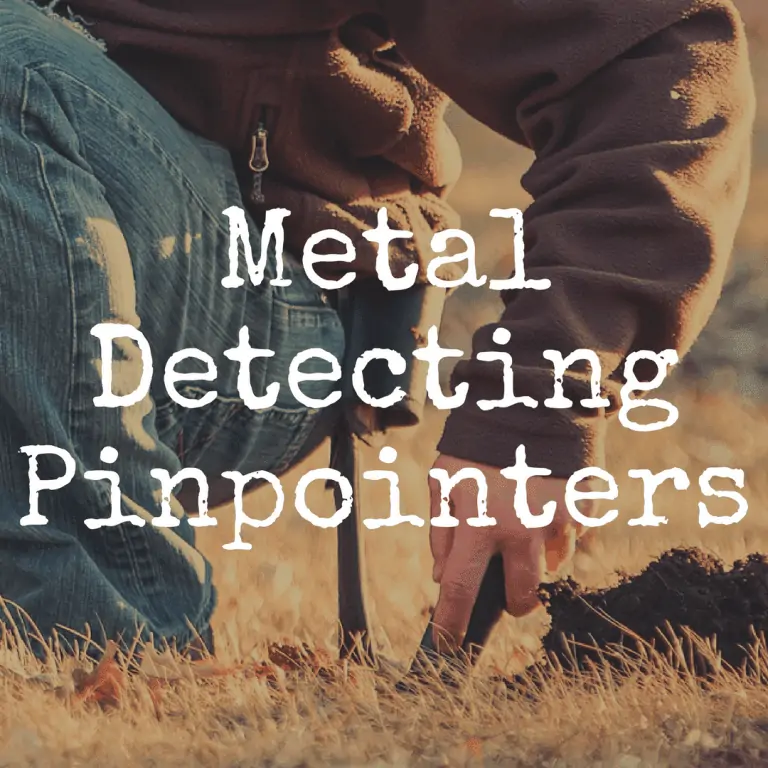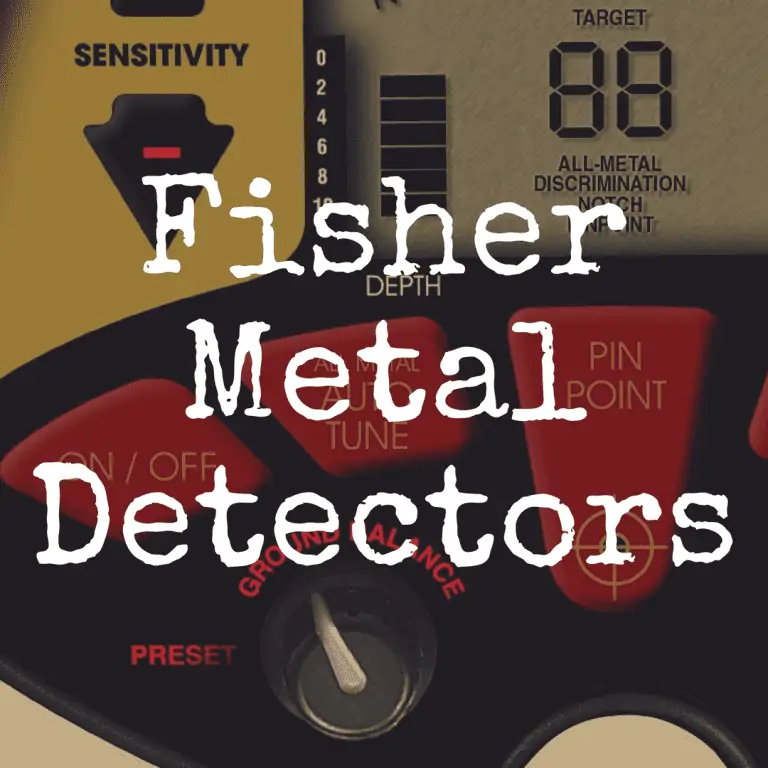Bounty Hunter vs. Garrett: Best Metal Detector Brand?
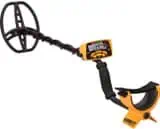
When you are deciding which metal detector manufacturer to purchase from, there can be a lot of confusion. All metal detector manufacturers make great products, and often, it comes down to personal preference. Bounty Hunter and Garrett are both well-known metal detector manufacturers that have been producing quality products for many years. Both companies make multiple models for different skill levels, different types of treasure, and at different price points. Garrett metal detectors are more expensive than Bounty Hunter metal detectors. But Bounty Hunter metal detectors are simpler to use.
This article will break down some of the most popular models from both companies, compare prices, and directly compare the Bounty Hunter metal detectors to Garrett metal detectors. Hopefully, we can ease some of the confusion surrounding buying your next (or first) metal detector!
And to better help you, please use our interactive guide below, which allows you to compare Bounty Hunter and Garrett metal detectors against some of the top metal detecting machines and brands available:
| Photo | Model | Price | Features |
|---|---|---|---|
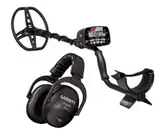 | Garrett AT Max | $$$ | Waterproof to 10 feet |
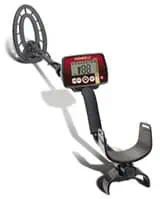 | Fisher F22 | $$ | 9″ Triangulated Concentric Coil |
 | Garrett Ace 400 | $$$ | 8.5 x 11" DD coil |
 | Minelab Vanquish 540 | $ | Search Modes: Coin, Relic, Jewelry, Custom, All Metal |
About Bounty Hunter
Bounty Hunter metal detectors are typically seen as a lower end brand specifically made for children or beginning detectorists on a budget. Bounty Hunter is owned by First Texas Products, which is the same company that owns Fisher Labs and Teknetics. First Texas Products is an American-made and run corporation that has a solid history in the metal detecting world. Bounty Hunter has been making and selling metal detectors since 1988.
One great feature of the Bounty Hunter line is their price. They are typically not as expensive as some other manufacturer’s metal detectors. Bounty Hunter makes models specifically for kids. Kids will like the simplicity and ease of the children’s models. They do not have as many features as advanced detectors but are perfect for younger kids who would be overwhelmed with complicated metal detectors. They also make models that are perfect for older kids and teenagers. Each one is lightweight and simple to use, making them perfect for kids.
They are not just for kids, though. Bounty Hunter metal detectors are prefect for anyone on a strict budget who wants to enter the metal detecting world. The lower end metal detectors from Bounty Hunter are simple to use, and will give new detectorists, regardless of age, a taste of the metal detecting world. These detectors are inexpensive, so there is always a chance to upgrade in the future because you have not shelled out a lot of money upfront.
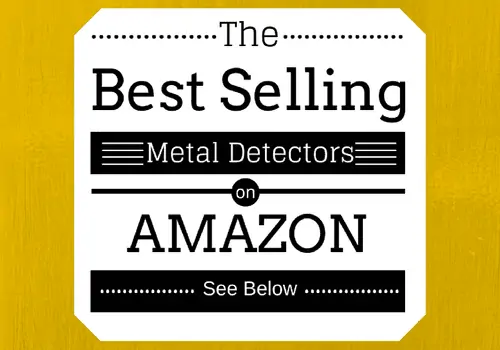
Below, please take a moment to view some of the best selling metal detectors currently available on today’s market:
| BEST SELLERS |
|---|
| 1) Garrett AT MAX |
| 2) Bounty Hunter TK4 Tracker IV |
| 3) Bounty Hunter Gold Digger |
Bounty Hunter Models
Bounty Hunter makes several models of metal detector for different skill levels. The Bounty Hunter Junior is perfect for kids ages 4 to 9. This detector looks like a miniature version of an adult detector, which kids will like! The Junior is very lightweight and easy for kids to swing. It only weighs 1.5 pounds and has an adjustable stem. This model does have a discrimination mode to help filter out trash. This is an incredibly simple to use model and can be turned on and used directly out of the box.
There are no complicated settings to bother with and will be perfect for smaller children. An easy to use metal detector like the Bounty Hunter Junior will be a great introduction for kiddos to the metal detecting world. Plus, if they decide they are not keen on metal detecting, you are not out a whole lot of money.

Kids age 10 and over will find the Bounty Hunter Tracker IV or Bounty Hunter Quicksilver good options. These 2 models are also appropriate for adult detectorists who are just starting out. They have limited features, so they are easy to use. The Tracker IV comes with an 8” concentric waterproof search coil, so it can be used in shallow waters.
The control box is not waterproof, so caution should be used in water. It comes with preset ground balancing, meaning less false positive signals in highly mineralized ground conditions. This model also has adjustable sensitivity and discrimination. The Tracker IV does not have an LCD screen. It comes with an analog display. This model operates on 2 9-volt batteries.
The Quicksilver is another great option for older kids or beginning detectorists. This model gives users a visual depth indicator showing the approximate depth of a target. The Quicksilver does not have adjustable ground balancing, so it may struggle in highly mineralized soil conditions. This model comes with an 8” waterproof concentric search coil, like the Tracker IV. One major difference is the Quicksilver comes with an LCD screen. Both models operate at 6.6 kHz, so they will not be appropriate for finding gold.
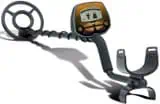
For older teens or adults, the Bounty Hunter Lone Star Pro is a good option. This machine is good for detectorists with some experience. It has all the functions of the Quicksilver but has 3 search modes to the Quicksilver’s single mode. The Lone Star Pro has All-Metal Mode, Discrimination Mode, and Auto Notch Mode, while the Quicksilver only has Discrimination Mode.
This model also has more digital target identification segments so you will have a better idea of what type of treasure you are digging. The Lone Star Pro is heavier than some Bounty Hunter models, at 3.5 pounds. It comes with an 8” concentric waterproof search coil and operates at 7.69 kHz.
The Bounty Hunter Quick Draw Pro is another great model for older teenager or adult detectorists. The main difference between the Quick Draw Pro and Lone Star Pro is the numerical target ID present on the Quick Draw Pro. This lets users identify the type of metal they have found more accurately than other Bounty Hunter models.
This detector also features a pinpoint mode, something not found on less expensive models. Iron Audio is also present on the Quick Draw Pro. This helps you not dig nuisance items like bottle caps. The search coil is waterproof so it can be used in shallow waters. This model weighs 2.4 pounds, so it still a very lightweight model. This model comes with a 10 “elliptical waterproof search coil and operates at 7.69 kHz.

Next up in the line up is the Bounty Hunter Time Ranger. This model is heavier than others, at 4 pounds. This machine has adjustable sensitivity and Ground Trac automatic ground balancing, which constantly scans the ground to check for mineralization. The Time Ranger will automatically adjust to ground conditions using this feature and allow for better depth and more accurate target identification.
The display screen can be a bit confusing as there is so much information displayed and so many buttons to choose from. This could be an issue for beginning detectorists or children, so this model is recommended for older teenagers or adults with some experience. This model does have numerical depth readout, so you know approximately how deep to dig and numerical target identification to help you know what type of target you are digging.
Last on our list of Bounty Hunter Models is the Bounty Hunter Land Ranger Pro. This is one of the best models in the Bounty Hunter family. It is lightweight at just 2.5 pounds. It features numerical target identification and depth readout, like the Time Ranger. It has greater depth than other Bounty Hunter models and can find a coin at 10 inches deep in the right conditions. This model also has more search modes than other Bounty Hunter models:
- Coins
- Jewelry
- Relics
- Program #2 – 2 Tones
- Program #3 – 3 Tones
- Program #4 – 4 Tones
- All Metal Mode
The Land Ranger Pro has Ground Trac ground balancing to help in highly mineralized soil conditions. It operates at 7.69 kHz and comes with an 11” waterproof Double-D search coil. As with all Bounty Hunter models, the control box is not waterproof, so caution should be exercised around water.
About Garrett
Charles and Eleanor Garrett began making and selling metal detectors in 1964. They focused on making the best metal detectors and selling them at reasonable costs. Garrett has always made it a point to ensure customers remain their top priority. In the beginning, Charles Garrett found most commercial metal detectors unsatisfactory. He began working in his garage to build a better metal detector. By 1965, Garrett was right in the pack with other metal detector manufacturers and continued to improve his metal detectors to outperform the competition.
Garrett was the first manufacturer to eliminate oscillator drift with his patented independently operated search coils. This greatly improved treasure hunting efficiency. Besides personal, sport metal detectors, Garrett also makes countermine detectors, school metal detectors, and security metal detectors. Garrett has been in business longer than Bounty Hunter, and often has a better reputation for quality products. Garrett metal detectors have great features, are quality detectors, and come in a variety appropriate for all skill levels. They are more expensive than Bounty Hunter metal detectors, but you do get much more when you purchase a Garrett metal detector.
Garrett Models
Garrett’s Ace line consists of 3 detectors: The Garrett Ace 200, Garrett Ace 300, and Garrett Ace 400. These models are great for entry level or more intermediate detectors. All 3 models weight just under 3 pounds and operate on 4 AA batteries. Each has an adjustable length so they can be tailored to the detectorist.
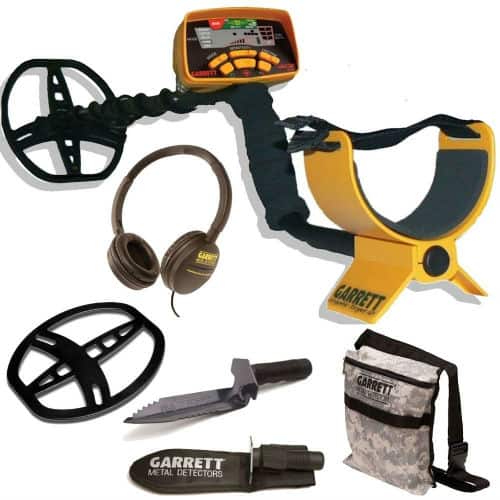
The Garrett Ace 200 is the least expensive and easiest to use. It comes with a 9” concentric search coil and operates at a 6.5 kHz fixed frequency. It does not feature a pinpoint mode or Iron Audio. It only has 1 discrimination segment, 4 sensitivity and depth adjustments, and 3 search modes. The Ace 300 and 400 have adjustable notch discrimination, 4 iron discrimination segments, but does not have Iron Audio.
The Ace 300 and 400 both have 8 sensitivity and depth adjustments and pinpoint mode. They also have 5 search modes. The Ace 300 operates at an adjustable 8 kHz, and the Ace 400 at an adjustable 10 kHz. The Ace 300 comes with a 10” concentric search coil, and the Ace 400 an 11” Double-D search coil. The Ace 300 and 400 come with headphones, an Ace Cover-up, and coil cover.
Garrett’s AT line is more advanced than the Ace line. This line consists of the Garrett AT Pro, Garrett AT Gold, and Garrett AT Max. The AT Max features wireless headphone technology. The AT Max and Gold feature 44 iron discrimination segments and true All-Metal Mode. The AT Pro features 40 iron discrimination segments but does not have All-Metal Mode.
The AT Max is the only model with a backlight or volume adjustment. The AT Max and Pro have adjustable Notch Discrimination, while the Gold has preset Notch. The AT Pro has 6 search modes, the Gold has 3 search modes, and the Max has 4 search modes. The weight on all 3 metal detectors is right around 3 pounds.
All 3 models have proportional audio, quick recovery speed, iron discrimination mode, and 8 sensitivity and depth adjustments. All 3 models have digital target ID, automatic and manual ground balancing, and pinpoint mode. All are also waterproof up to 10 feet, which is a handy feature for those detecting in rivers, streams, beaches, and lakes. The AT Gold is not recommended for use in saltwater areas, while the Pro and Max are fine to use. The AT Pro operates at 15 kHz, the Gold at 18 kHz, and the Max at 13.6 kHz, all adjustable.

One of the best detector Garrett makes is the Garrett ATX. This is a pulse induction (PI) metal detector with superior sensitivity and depth. PI machines also work extremely well in saltwater settings. This detector is far superior at finding small, low conductive targets like fine gold jewelry and sub gram gold nuggets. It features Fast Track ground balancing to help eliminate electromagnetic interference and mineralization, despite being inherently immune to saltwater.
The ATX also has continuous GroundTrack with 4 settings. The ATX is fully waterproof up to 10 feet and features motion and non-motion modes, plus pinpoint mode. PI machines are almost always heavier than traditional very low frequency (VLF) machines, and the ATX is no exception, weighing in at 6.9 pounds.
Price Comparisons
Bounty Hunter metal detectors are notoriously inexpensive. This is a huge perk to anyone on a budget who wants to enter the metal detecting world without spending a fortune.
- Junior – $70
- Tracker IV – $149
- Quicksilver – $159
- Lone Star Pro – $199
- Quick Draw Pro – $299
- Land Ranger Pro – $449
Beginner Garrett models are comparable to intermediate to higher end Bounty Hunter prices, but the higher end Garrett metal detectors are much more expensive.
- Ace 200 – $200
- Ace 300 – $300
- Ace 400 – $400
- AT Pro – $650
- AT Gold – $750
- AT Max – $850
- ATX – $2,495
Bounty Hunter vs Garrett Detectors
The Garrett ATX is the only PI machine on this list and is considerably more expensive than all the other models on this list. Therefore, it will not be compared to any Bounty Hunter model, as there is no equivalent in Bounty Hunter’s line up. The Bounty Hunter Junior also does not have an equivalent in Garrett’s line. Therefore, it will not be compared directly here, either.
The Bounty Hunter Tracker IV and Garrett Ace 200 are moderately comparable. However, the Ace 200 is a step up in terms of features. Unlike the Bounty Hunter, the Ace 200 has numerical target ID, digital control panel, and depth indicator. This provides more information about the type of material and depth than the Tracker IV can. The Bounty Hunter has a knob for adjusting discrimination, while the Ace 200 has 3 pre-set discrimination patterns that cannot be adjusted manually. Other Ace models come with adjustable notch discrimination and would provide greater control than the Tracker IV.
If it is within your budget, I would recommend the Garrett Ace line rather than the lower end Bounty Hunter models. The only exception is if you are purchasing a metal detector for kids. Bounty Hunter metal detectors, especially the Junior, Tracker IV, and Quicksilver, are perfect models for kids just starting out in the sport.
The Bounty Hunter Land Ranger Pro and Garrett AT Pro are also comparable models. One huge difference is the operating frequency. The AT Pro operates at 15 kHz, while the Land Ranger Pro only operates at 7.69 kHz. The higher frequency will be better at finding smaller gold objects, while the lower end frequency will be best for finding silver or nickel. The Land Ranger Pro has 7 search modes while the AT Pro has 6. However, coins can be detected up to 15 inches and large objects up to 40 inches with the AT Pro. The Land Ranger Pro can only detect coins up to 10 inches and large objects up to 24 inches.
The Land Ranger Pro has more sensitivity adjustments than the AT Pro. The AT Pro has a backlit LCD screen, while the Land Ranger Pro has an LCD screen with no backlight. The Land Ranger Pro has 4-tone audio while the AT Pro has 3 tone audio identification. Both have target indicators and numerical target ID. One of the biggest perks for the AT Pro is it is fully waterproof up to 10 feet, while the Land Ranger Pro has a waterproof search coil, but the control box is not waterproof. Bounty Hunter’s warranty is superior to Garretts; 5-years versus 2-years.
Again, if it is within your budget, I would recommend the Garrett AT Pro over the Bounty Hunter Land Ranger Pro.
Conclusion
When it comes right down to it, I would recommend Garrett metal detectors over Bounty Hunter metal detectors. While I do not think there is anything at all wrong with Bounty Hunter, Garrett has better features and superior performance. If you are on a budget or buying a metal detector for a child or beginning detectorist, there is absolutely nothing wrong with choosing a Bounty Hunter metal detector.
Both companies have been in business for many years, and there is obviously a reason for that. Garrett metal detectors are more expensive than Bounty Hunter metal detectors, especially if we add in the ATX, which is more expensive than all the Bounty Hunter models discussed here combined!
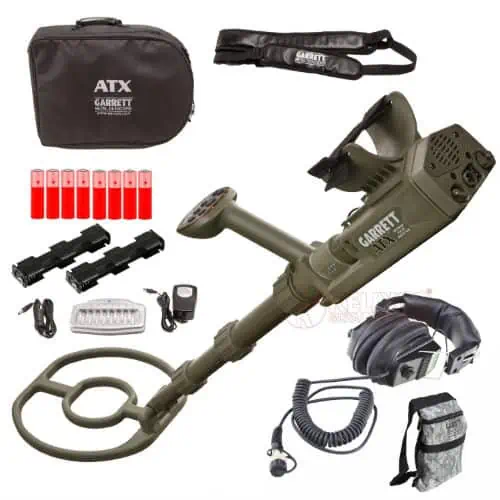
The Garrett ATX is in a class all its own. For a fair comparison, this model would have to go up against another PI machine, which Bounty Hunter does not currently produce. If we were to compare the ATX directly to the highest end Bounty Hunter, it would absolutely decimate the Bounty Hunter. I do realize that $2,500 is well above many people’s budget (mine included!). But if it fits within your budget and you have a reason to have PI machine, I cannot recommend the ATX enough.
The Bounty Hunter Junior, Quicksilver, and Tracker IV are perfect for kids. I would not recommend the Junior for an adult or teenager just starting out. The machine is extremely limited and does not have enough features for an older detectorist to really get a feel for metal detecting. The Quicksilver and Tracker IV are good for teenagers and beginning adults. But if your budget permits, I would still recommend the Garrett Ace line for a beginning detectorist.
For a more intermediate or advanced detectorist, I would recommend the Bounty Hunter Quick Draw Pro or Bounty Hunter Land Ranger Pro. Again, if your budget permits, I would recommend the Garrett AT line over the higher end Bounty Hunter metal detectors. Garrett’s AT metal detectors have many more features than the Bounty Hunter metal detectors and will be more appropriate for an advanced or intermediate detectorist.
Although these Bounty Hunter models are great and simple to use, the Garrett line has more features and would be best for an advanced detectorist. Intermediate and advanced metal detectorists will likely get bored with the limited features of the Bounty Hunter line. However, Bounty Hunter has a loyal fanbase, and again, there is a reason for that!
In conclusion, I would recommend Garrett metal detectors over Bounty Hunter, unless you are buying for a kiddo. No matter which detector you choose, you really cannot go wrong if you choose a Garrett metal detector!
- If you enjoyed this article, please “like” our Facebook page!
